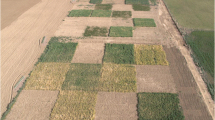Abstract
Global atmospheric CO2 is increasing at a rate of 1.5–2 ppm per year and is predicted to double by the end of the next century. Understanding how terrestrial ecosystems will respond in this changing environment is an important goal of current research. Here we present results from a field study of elevated CO2 in a California annual grassland. Elevated CO2 led to lower leaf-level stomatal conductance and transpiration (approximately 50%) and higher mid-day leaf water potentials (30–35%) in the most abundant species of the grassland, Avena barbata Brot. Higher CO2 concentrations also resulted in greater midday photosynthetic rates (70% on average). The effects of CO2 on stomatal conductance and leaf water potential decreased towards the end of the growing season, when Avena began to show signs of senescence. Water-use efficiency was approximately doubled in elevated CO2, as estimated by instantaneous gas-exchange measurements and seasonal carbon isotope discrimination. Increases in CO2 and photosynthesis resulted in more seeds per plant (30%) and taller and heavier plants (27% and 41%, respectively). Elevated CO2 also reduced seed N concentrations (9%).
Similar content being viewed by others
References
Arp WJ, Drake BG (1991) Increased photosynthetic capacity of Scipus olnei after four years of exposure to elevated CO2. Plant cell Environ 14:1003–1006
Barnola JM, Raynaud D, Korotkevitch YS, Lorius C (1987) Vostok ice core provides 160,000-year record of atmospheric CO2. Nature 329:408–414
Bazzaz FA (1990) The response of natural ecosystems to rising global CO2 levels. Annu Rev Ecol Syst 21:167–196
Bazzaz FA, Miao SL (1993) Successional status, seed size, and responses of tree seedlings to CO2, light, and nutrients. Ecology 74:104–112
Chapin FS III, Bloom AJ, Field CB, Waring RH (1987) Plant responses to multiple environmental factors. Bioscience 37:49–57
Curtis PD, Drake BG, Leadley PW, Arp W, Whigham DF (1989) Growth and senescence in plant communities exposed to elevated CO2 concentrations on an estuarine marsh. Oecologia 78:20–26
Dahlman RC (1993) CO2 and plants: revisited. Vegetatio 104/105:339–355
Ehleringer JR (1989) Carbon isotope ratios and physiological processes in aridland plants. In: Rundel PW, Ehleringer JR, Nagy KA (eds) Stable isotopes in ecological research. Springer, New York, pp 41–54
Farquhar GD, Hubick KT, Condon AG, Richards RA (1989) Carbon isotope fractionation and plant water-use efficiency. In: Rundel PW, Ehleringer JR, Nagy KA (eds) Stable isotopes in ecological research. Springer, New York, pp 21–40
Field CB, Chapin FS, Chiariello NR, Mooney HA, Holland E (1995) The Jasper ridge CO2 experiment: Design and Motivation. In Mooney HA, Koch GW (eds) Terrestrial ecosystem response to elevated CO2. Academic Press, London (in press)
Gammon RH, Sundquist ET, Fraser PJ (1985) In: Trabalka JR (ed) Atmospheric carbon dioxide and the global carbon cycle. US Department of Energy, Washington DC, pp 25–62
Garbutt K, Williams WE, Bazzaz FA (1990) Analysis of the differential response of five annuals to elevated CO2 during growth. Ecology 71:1185–1194
Gulmon SL (1979) Competition and coexistence: three annual grass species. Am Midl Nat 101:403–416
Idso SB, Kimball BA, Allen SG (1991) CO2 enrichment of sour orange trees: 2.5 years into a long-term experiment. Plant Cell Environ 14:351–353
Jarvis PG, McNaughton KG (1986) Stomatal control of transpiration: scaling up from leaf to region. Adv Ecol Res 15:1–49
Johnson RA, Wichern DW (1988) Applied multivariate statistical analysis. Prentice Hall, Englewood Cliffs NJ
Keeling CD (1986) Atmospheric CO2 concentrations. Mauna Loa Observatory, Hawaii 1958–1986 (NDP-001/R1). Carbon dioxide information analysis center, Oak Ridge TN
Körner C, Arnone JA III (1992) Responses to elevated carbon dioxide in artificial tropical ecosystems. Science 257:1671–1675
Larigauderie A, Hilbert DW, Oechel WC (1988) Effect of CO2 enrichment and nitrogen availability on resource acquisition in a grass, Bromus mollis. Oecologia 77:544–549
Long SP, Hutchin PR (1991) Primary production in grasslands and coniferous forests with climate change: an overview. Ecol Appl 1:139–156
McNaughton SJ (1968) Structure and function in California grasslands. Ecology 49:962–972
Mooney HA, Hbbs RJ, Gorham J, Williams K (1986) Biomass accumulation and resource utilization in co-occurring grassland annuals. Oecologia 70:555–558
Morison JIL (1993) Response of plants to CO2 under water limited conditions. Vegetatio 104/105:193–209
Norby RJ, Gunderson CA, Wullschleger SD, O'Neill EG, McCracken MK (1992) Productivity and compensatory responses of yellow-poplar tress in elevated CO2. Nature 357:322–324
Radoglou KM, Aphalo P, Jarvis PG (1992) Response of photosynthesis, stomatal conductance and water use efficiency to elevated CO2 and nutrient supply in acclimated seedlings of Phaseolus vulgaris. Ann Bot 70:257–264
rogers HH, Thomas JF, Bingham GE (1983) Response of agronomic and forest species to elevated atmospheric carbon dioxide. Science 220:428–429
Schlesinger WH (1991) Biogeochemistry. Academic Press, San Diego
Scholander PF, Hammel HT, Bradstreet ED, Hemminsen EA (1965) Sap pressure in vascular plants. Science 148:339–346
Smith SD, Strain BR, Sharkey TD (1987) Effects of CO2 enrichment on four Great Basin grasses. Funct Ecol 1:139–143
Tissue DT, Oechel WC (1987) Response of Eriophorum vaginatum to elevated CO2 and temperature in the Alaskan tussock tundra. Ecology 68:401–441
Tyree MT, Alexander JD (1993) Plant water relations and the effects of elevated CO2: a review and suggestions for future research. Vegetatio 104/105:47–62
van Der Burgh J, Visscher H, Dilcher DL, Kürschner WM (1993) Paleoatmospheric signatures in neogene fossil leaves. Science 260:1788–1790
Williams WE, Garbutt K, Bazzaz FA (1988) The response of plants to elevated CO2 V. Performance of an assemblage of serpentine grassland herbs. Environ Exp Bot 28:123–130
Woodward FI, Thompson GB, McKee IF (1991) The effects of elevated concentrations of carbon dioxide on individual plants, populations, communities and ecosystems. Ann Bot 67:23–38
Author information
Authors and Affiliations
Rights and permissions
About this article
Cite this article
Jackson, R.B., Sala, O.E., Field, C.B. et al. CO2 alters water use, carbon gain, and yield for the dominant species in a natural grassland. Oecologia 98, 257–262 (1994). https://doi.org/10.1007/BF00324212
Received:
Accepted:
Issue Date:
DOI: https://doi.org/10.1007/BF00324212




